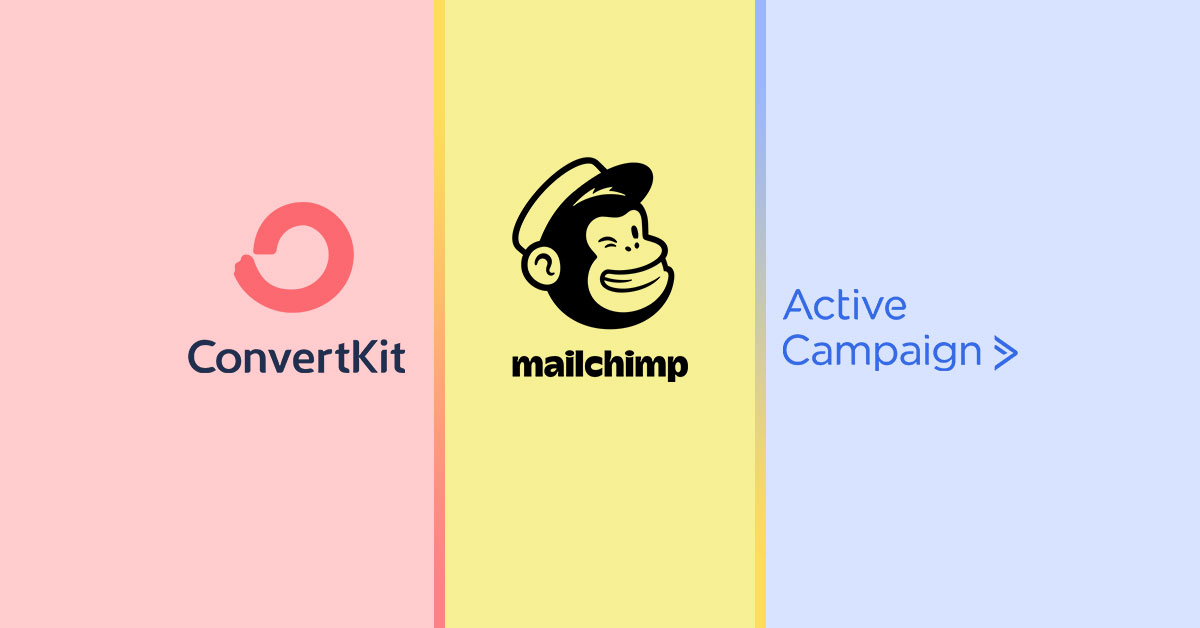Mailchimp vs ConvertKit vs ActiveCampaign, Which email marketing service is the best choice for you?
Email marketing is a crucial tool for businesses of all sizes, as it allows them to reach and engage with their customers and prospects through targeted, personalized messages. With so many options available, it can be overwhelming to choose the right email marketing platform for your business. In this post, we’ll be comparing three popular email marketing tools: Mailchimp, ConvertKit, and ActiveCampaign. Each of these platforms has its own unique features and capabilities, and in this article, we’ll take a detailed look at what they have to offer and help you decide which one is the best fit for your business.
Mailchimp vs ConvertKit vs ActiveCampaign, Which is the Best for Your Needs?
1. Overview of Mailchimp
Mailchimp is a well-known and widely used email marketing platform, with a user-friendly interface and a range of features designed to help businesses of all sizes create and send professional-looking emails. Some of the key features offered by Mailchimp include templates and design tools for creating visually appealing emails, segmentation options for targeting specific groups of subscribers, and integration with popular e-commerce platforms.

One of the pros of using Mailchimp is its versatility – it’s a suitable platform for businesses of all sizes and industries. It’s also relatively easy to use, with a drag-and-drop editor and a range of templates and design tools to choose from. Additionally, Mailchimp offers a free plan for users with small lists, making it a budget-friendly option for businesses just starting out with email marketing.
However, there are also some cons to consider when using Mailchimp. One issue that some users have reported is that the platform can be slow to load, which can be frustrating when trying to work quickly. Additionally, some users have reported experiencing issues with deliverability, with emails ending up in spam folders more often than they would like. Finally, while Mailchimp offers a range of features, it may not be as feature-rich as some other email marketing platforms on the market.
2. Overview of ConvertKit
ConvertKit is an email marketing platform specifically designed for professional bloggers, online course creators, and other content creators. It offers a range of features to help these users grow their email lists and automate their email marketing efforts. Some of the key features of ConvertKit include customizable opt-in forms, customizable email sequences, and the ability to segment subscribers based on their interests and actions.

One of the pros of using ConvertKit is that it’s designed with content creators in mind, and it offers a range of features specifically tailored to this audience. It’s also relatively easy to use, with a clean and intuitive interface. Additionally, ConvertKit offers excellent deliverability rates, which is important for ensuring that your emails reach your subscribers’ inboxes.
However, there are also some cons to consider when using ConvertKit. One issue is that the platform is relatively expensive compared to some other options on the market. It also doesn’t offer as many design and customization options as some other platforms, which can be a drawback for users who want more control over the appearance of their emails. Finally, ConvertKit doesn’t offer a free plan, which may not be suitable for businesses just starting out with email marketing.
3. Overview of ActiveCampaign
ActiveCampaign is a comprehensive email marketing and customer relationship management (CRM) platform that offers a range of features to help businesses of all sizes grow and engage their audience. Some of the key features of ActiveCampaign include customizable templates and design tools, advanced segmentation options, and integration with a range of third-party apps and services.

One of the pros of using ActiveCampaign is its versatility – it’s suitable for businesses of all sizes and industries, and it offers a range of features to support marketing, sales, and customer service efforts. It’s also highly customizable, with a range of templates and design tools to choose from, as well as advanced segmentation options for targeting specific groups of subscribers. Additionally, ActiveCampaign offers a range of integrations with third-party apps and services, which can be helpful for businesses looking to streamline their workflows.
However, there are also some cons to consider when using ActiveCampaign. One issue is that the platform can be somewhat overwhelming for users who are new to email marketing, as it offers a large number of features and customization options. Additionally, ActiveCampaign is relatively expensive compared to some other options on the market, and it may not be suitable for businesses on a tight budget. Finally, some users have reported experiencing issues with deliverability, with emails ending up in spam folders more often than they would like.
4. Comparison of features and pricing
When it comes to choosing an email marketing platform, it’s important to consider not only the features offered, but also the pricing. Here’s a comparison of the features and pricing of Mailchimp, ConvertKit, and ActiveCampaign:
1. Mailchimp
- Offers a range of templates and design tools for creating visually appealing emails
- Segmentation options for targeting specific groups of subscribers
- Integration with popular e-commerce platforms
- Free plan available for users with small lists
- Paid plans start at $10/month for the Essentials plan, which includes basic features such as automation and customizable templates
2. ConvertKit
- Customizable opt-in forms and email sequences
- Segmentation based on subscriber interests and actions
- No free plan available
- Paid plans start at $29/month for the Creator plan, which includes basic features such as customizable forms and email sequences
3. ActiveCampaign
- Customizable templates and design tools
- Advanced segmentation options
- Integration with a range of third-party apps and services
- No free plan available
- Paid plans start at $9/month for the Lite plan, which includes basic features such as customizable templates and segmentation
Please note that these are just general overviews of the features and pricing of each platform, and the specific details may change over time. It’s important to carefully review the features and pricing of each platform to determine which one is the best fit for your business.
5. Pros and cons of Mailchimp, ConvertKit and ActiveCampaign
1. Pros of using Mailchimp
- Mailchimp is known for its ease of use and straightforward setup process. The user interface is also attractive and intuitive.
- A user-friendly service is one that is designed with the needs and preferences of the user in mind. It is easy to use, intuitive, and requires minimal effort to learn and navigate. A user-friendly service is typically designed with clear and concise instructions and a logical layout, making it accessible and enjoyable for users of all skill levels.
2. Cons of using Mailchimp
- If legitimate emails are frequently marked as spam, it can put your account at risk of suspension or even deletion. It is important to take steps to ensure that important emails are not mistakenly marked as spam.
- The customer support was poor and when I asked for help using the platform, the company terminated our relationship citing spam as the reason.
3. Pros of using ConvertKit
- ConvertKit is an ideal solution for beginners because it provides all the necessary features and can be integrated with various third-party tools.
- ConvertKit has excellent customer service and a unique, easy-to-use interface called the visual builder. Additionally, it offers good value for its price.
4. Cons of using ConvertKit
- There are certain areas of the platform that do not have autosave functionality, which has caused me to lose content in the past.
- It is normal to make mistakes and face a learning curve when running a business. These are inevitable and should be expected.
5. Pros of using ActiveCampaign
- Even after the onboarding process is completed, you have ongoing access to their helpful support staff. The standout feature of their service is the quality of the assistance provided.
- ActiveCampaign has a clear interface and includes many useful features that can be utilized as your business grows and evolves over time.
6. Cons of using ActiveCampaign
- Despite its best efforts, the product is unable to prevent spam emails created by malicious individuals from getting through. It is possible for spam contacts to enter the system.
Conclusion
In this post, we’ve compared three popular email marketing platforms: Mailchimp, ConvertKit, and ActiveCampaign. Each of these platforms has its own unique strengths and weaknesses, and the best choice for your business will depend on your specific needs and goals.
Mailchimp is a versatile platform that’s suitable for businesses of all sizes and industries, and it offers a range of features and design tools to help you create professional-looking emails. It’s also relatively easy to use, and it offers a free plan for users with small lists. However, it may not be as feature-rich as some other options on the market, and some users have reported issues with deliverability.
ConvertKit is a platform specifically designed for professional bloggers and other content creators, and it offers a range of features tailored to this audience. It’s relatively easy to use, and it offers excellent deliverability rates. However, it’s relatively expensive compared to some other options on the market, and it doesn’t offer as many design and customization options as some other platforms.
ActiveCampaign is a comprehensive email marketing and CRM platform that offers a range of features to support marketing, sales, and customer service efforts. It’s highly customizable, with a range of templates and design tools to choose from, and it offers a range of integrations with third-party apps and services. However, it can be somewhat overwhelming for users who are new to email marketing, and it’s relatively expensive compared to some other options on the market.
Ultimately, the best email marketing platform for your business will depend on your specific needs and goals. Carefully consider the features and pricing of each platform to determine which one is the best fit for your business.







